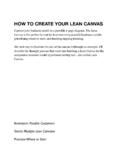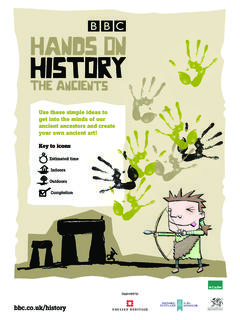Transcription of Create Your Future the Peter Drucker Way
1 Create your . Future . THE Peter . Drucker WAY. Developing and Applying a Forward-Focused Mindset BRUCE ROSENSTEIN. New York Chicago San Francisco Athens London Madrid Mexico City Milan New Delhi Singapore Sydney Toronto CONTENTS. Preface ix Chapter 1 Create a Future -Focused Mindset 1. Chapter 2 Determine the Future That Has Already Happened 31. Chapter 3 Become your Own Successor 61. Chapter 4 Shape the Future of your Organization 95. Chapter 5 Build your Future Beyond your Current Workplace 127. Conclusion: your Future Begins Today 159. A Selected Reader's Guide to Drucker 's Writings on the Future 161.
2 Online Resources 165. Index 187. vii chap ter 1. C R E AT E A F U T U R E - FOCUSED MINDSET 1. People must take as much control of their own Future as possible. Increasingly even long-lived institutions have become unstable, and many companies can't or won't provide the security that earlier gen- erations of workers could count on. Gone are the days when you could take for granted corporate or even government benefits. In their 2010 book The Truth about Leadership, top leadership authors Jim Kouzes and Barry Posner write, The capacity to imagine and articulate exciting Future possibilities is the defining competence of leaders.
3 Leaders are custodians of the Future . They are concerned about tomorrow's world and those who will inherit it.. Peter Drucker 's writing on the Future was sharp and perceptive. In helping you to best understand his approach to the subject, I have organized into a framework his ideas on the subject, beginning with what I believe are the 10 main elements, Drucker 's core beliefs about the Future . These elements, outlined below, can be applied by both individuals inside and outside the workplace, as well as by organiza- tions, business or otherwise. Most of the readers of this book will be what Drucker called knowledge workers.
4 You depend more on brains rather than brawn in your daily job. your work centers on learning, conveying, applying, and developing knowledge, based on what you have learned throughout your life and what you will continue to learn. The portable and mobile nature of this knowledge meant, Drucker believed, that you own your 1. 2 Create your Future THE Peter Drucker WAY. own means of production. Knowledge workers are found in a variety of positions within business, academia, nonprofits, government, and related fields. They can be leaders and managers, scientists, doctors, lawyers, teachers, information technology workers, clergy, librarians, archivists, and many other professionals.
5 Peter Drucker 101. Peter Drucker (1909 2005) developed an approach and a mindset to the Future that permeated his work as a writer, teacher, and consultant. His working life continued for more than 70 years. It encompassed writing more than 40 books, contributing regularly to such publications as the Harvard Business Review, Forbes, and the Wall Street Journal;. consulting for companies, nonprofit organizations, and governments;. and teaching at a school that eventually was named for him, the Peter F. Drucker and Masatoshi Ito Graduate School of Management, at Claremont Graduate University, in Claremont, California.
6 He was awarded the Presidential Medal of Freedom, the nation's highest civil- ian honor, by President George W. Bush in 2002. Drucker was born and raised in Vienna, went to college in Germany, then lived and worked for several years in London, before immigrating to the United States in 1937. He and his wife, Doris Drucker , were mar- ried for 68 years, with four children and six grandchildren. Before moving to Claremont in 1971, he taught at (in reverse order) New York University, Bennington College, and Sarah Lawrence College. While living in London, he began an intense, lifelong interest in Japanese art.
7 He taught a course on the subject during the 1980s at Pomona College in Claremont. You can read the illuminating 18-page essay, A View of Japan through Japanese Art, in the 1993 collection The Ecological Vision: Reflections on the American Condition. He Create A Future -FOCUSED MINDSET 3. and Doris developed an important collection, the Sanso Collection. I attended the opening of an exhibit, Zen! Japanese Paintings from the Sanso Collection, at the Ruth Chandler Williamson Gallery at Scripps College on the Claremont campus during the beginning of the Drucker Centennial in 2009.
8 He had many other interests in life, including mountain hiking, music, and literature. He engaged in intense, three-year self-study projects until nearly the end of his life. And though most of his books were either about business or societal issues, he even wrote two novels, The Last of All Possible Worlds (1982) and The Temptation to Do Good (1984). His influence remains strong, and his ideas continue to reverber- ate throughout social media all day, every day. A number of books about him have been published since his death. For the 100th anni- versary of his birth, there was a major, yearlong commemoration, the Drucker Centennial, at the Drucker School and the Drucker Institute.
9 It began in November 2009 and ended in 2010. I was privileged to participate in 2010, as part of a panel of authors who had written Drucker -themed books. In 2009 the Harvard Business Review published an extensive, 19-page cover feature, The Drucker Centennial: What Would Peter Do? It included articles by luminaries such as Harvard Business school professor and best-selling author Rosabeth Moss Kanter and brief What I Learned from Peter Drucker essays by Frances Hesselbein, Lafley (the recently returned chairman and CEO of Procter & Gamble), and Zhang Ruimin (CEO of Haier Group, China), among others.
10 At the same time, Leader to Leader published an entire special issue, Celebrating the Peter F. Drucker Centennial, with articles by Hesselbein; Rick Wartzman, executive director of the Drucker Institute; Jim Collins, author of Good to Great; leadership guru 4 Create your Future THE Peter Drucker WAY. Marshall Goldsmith, and others. And in spring 2009, the Journal of the Academy of Marketing Science also published an entire special issue, A Tribute to Peter Drucker , which included Wartzman's inter- view of A. G. Lafley and an interview of Drucker by Drucker School professor Jenny Darroch, one of the editors of the issue.






